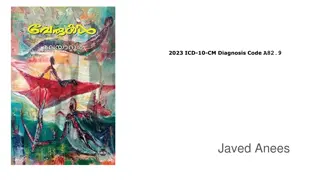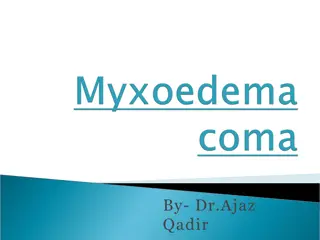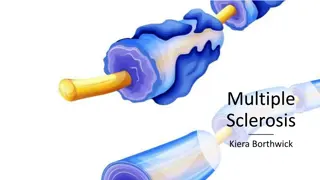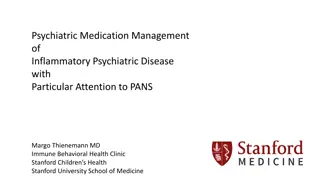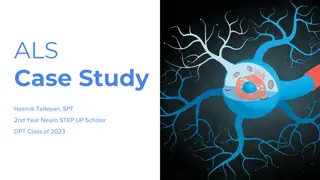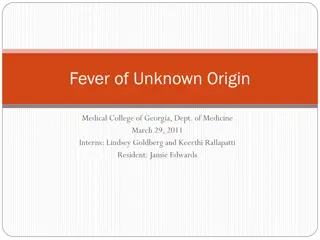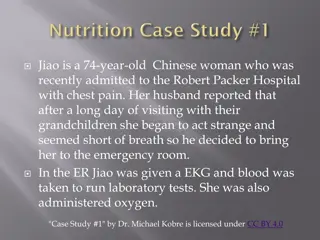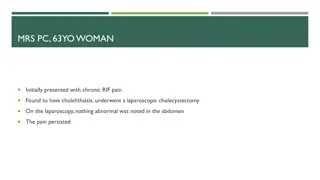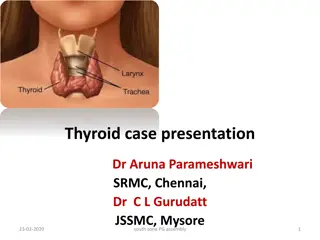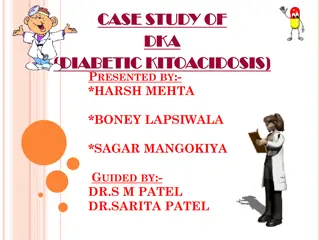Case Presentation: 25-Year-Old Woman with Multiple Symptoms
A 25-year-old woman presented with weakness, reduced physical strength, nausea, anorexia, significant weight loss, dizziness, syncope, heart rate instability, and arthralgia without arthritis. Diagnostic tests revealed abnormalities in various lab parameters and imaging studies. Further evaluation is required to determine the underlying cause of her symptoms.
Download Presentation

Please find below an Image/Link to download the presentation.
The content on the website is provided AS IS for your information and personal use only. It may not be sold, licensed, or shared on other websites without obtaining consent from the author.If you encounter any issues during the download, it is possible that the publisher has removed the file from their server.
You are allowed to download the files provided on this website for personal or commercial use, subject to the condition that they are used lawfully. All files are the property of their respective owners.
The content on the website is provided AS IS for your information and personal use only. It may not be sold, licensed, or shared on other websites without obtaining consent from the author.
E N D
Presentation Transcript
In the name of God Case presentation Mahsa Farahani ,MD Research institute for endocrine sciences Shahid Beheshti university of medical sciences 6 November 2023
Present illness A 25-year-old woman complained of Weakness Reduced physical strength Nausea Anorexia Weight loss 18kg/6months Dizziness and syncope Heart rate instability Arthralgia without arthritis Began 6 months before admit
Present illness For syncope attacks and heart rate instability: ECG holter 7days and BP Holter monitoring Office BP monitoring: orthostatic hypotension ECG Holter monitoring: no arrhythmia Baseline daytime heart rate elevated :110bpm Echocardiogram: EF 60% and just mitral valve prolaps
Present illness Pars laboratory 1402/4/11 Reference range CBC WBC:6500 Hb:13.6 plt:258000 FBS 80 mg/dl Cr 0.6 mg/dl calcium 9.6 mg/dl 8.5-10 Phosphorus 3.6 mg/dl 2.5-4.5 LFT AST:27 ALT:17 ALP:64 Na K 139 mEq/l 4.2 mEq/l 132-145 3.6-5.2 TSH 0.8 uIU/ml 0.3-4.2 cortisol8Am 7.07 mcg/dl 6.2-20
Present illness Pars laboratory 1402/5/13 Reference range Na 139 mEq/L 132-145 K 4.1 mEq/L 3.6-5.2 cortisol8Am 2.28 mcg/dl 6.2-20 ACTH <5.00 pg/ml 7.2-64
Present illness 1402/6/2 danesh Reference range FBS 81 mg/dl cr 1 mg/dl bun 12 mg/dl calcium 9.5 mg/dl 8.4-10.5 Na 139 mm0l/l 135-146 k 4.1 mmol/l 3.5-5.1 CRP 2.3 mg/l 0-8 ESR 5 mm/hr Up to 12mm/hr IPTH 23.9 pg/ml 15-68
Present illness 1402/6/2 Danesh Reference range ACTH 9.7 pg/ml 7.2-63.3 Cortisol 8AM 4.7 mcg/dl 3.7-19.4 TSH 0.7 mIU/L 0.35-4.94 t4 5.9 mcg/dl 4.8-11.7 t3 0.8 ng/ml 0.35-1.93 AntiTPO <1.0 Iu/ml <5.6 IGF1 270.7 ng/ml 92.9-342 prolactin 7.2 ng/ml 5.1-26.5 estradiol 34 pg/ml F:21-251 L:21-321
Present illness 1402/6/2 Danesh Reference range FSH 6.6mIU/ml LH 3.8mIU/ml ALDOSTERONE (upright) 76.0 pg/ml 37.0-432 RENIN (upright) 18.7 mcIU/ml 5.3-99.1 WBC Hb 6800/Ml 14.2/Ml PLT 270000/Ml
Present illness from 1402/5/20 hydrocortisone 20 mg per day was started for her On 1402/6/8 she was admitted with hypotensive symptoms resistant to hydrocortisone and iv hydration So fludrocortisone 0.1 mg was started
Present illness With fludrocortisone her SBP went from 80 to 100-110mmHg She was treated with hydrocortisone 15mg in morning ,10mg afternoon, 7 mg at night along with fludrocortisone 0.1mg daily She was better in symptoms with this treatment
Present illness on 1402/6/15 she felt numbness and heaviness on one side of her body and face and went to emergency room SBP raised to 150 mmHg Brain CT was normal Fludrocortisone was D/C
Present illness On 1402/6/22 she developed lateralized neurologic symptoms with Rt side hemiparesis of body and face Rt eye ptosis Dysarthria Normal brain MRI,MRA,CTA of brain & neck SBP:113-120/80 Her symptoms were resolved after 5-6 hours
Cosyntropin test (250mcg) Reference range Pars 1402/7/5 ACTH 17.3 pg/ml 7.2-64 Cortisol AM 4.61 mcg/dl 6.2-20 Cortisol 30 8.23 mcg/dl Cortisol 60 10.1 mcg/dl
Pituitary MRI Normal pituitary parenchyma Normal size Normal stalk No adenoma
color Doppler Sonography of the Thyroid gland and neck:(1402/7/16) Rt lobe:37x7x11 mm.1.7 cc Lt lobe:37x9x12.2cc Both thyroid lobes: normal size Homogeneously decreased parenchymal echo: chronic lymphocytic thyroiditis (Hashimoto) Few 2-4 mm colloid and spongiform cysts (TIRAD II, not suspicious) No pathologic lymph nod
Past medical history Anaphylaxis due to Diphrerline on 1386(age 9) Galactorrhea and prolonged vaginal bleeding 30 days on 1392(age15) TSH :4.7 , prolactin:16ng/ml (3-14.4) Brain MRI: pituitary microadenoma 3.2x2.1mm Dysmenorrhea and pelvic pain since beginning of menstruation
Past medical history Pelvic endometriosis : 2 laparoscopic surgery On 1398 (age21) On 1400 (age23) due to drop foot suspicious to pressure effect of endometriosis 3 aneurysms of gluteal artery the largest 1.5 cm 0n 1400 an IUD was implanted for the patient Amenorrhea after implanting IUD ADHD Recurrent sprain and casting of ankle
Drug history lisdexamphetamine discontinued from2 months ago IUD levonorgestrel 19.5 mg from 1400 Hydrocortisone 15-20 mg /day Fludrocortisone 0.1 mg /day discontinued from 1402/6/15
Family history Mother: RA, idiopathic chronic pancreatitis, Hashimoto Father: DM2 Aunt : AS Maternal aunt and her daughter: SLE Maternal cousin : Addison
Physical exam Head and nick : no hair loss , no mucosal hyperpigmentation, thyroid with normal size and rubbery without nodule , no LAP Chest : auscultation of lung: clear and heart :nl s1&s2 without murmur Breast development B5, NL areola pigmentation , NO mass Abdomen :NL, laparoscopic scars were seen Genitali:P5 , NL Musculoskeletal:4 extremity force: 5/5 , hypermobility of joints+, prominent coccyx, lipoatrophy 3x3 cm in left buttock Skin : no pathologic pigmentation or vitiligo , no hirsutism ,hyper extensivity, multiple scars in forearm BP:100/75(supine) PR:75 RR:18 T:36/5 BP:90/70 (upright)
Problem list A 25 y/o woman with Weakness Nausea Anorexia 18kg weight loss/6months Hypotension( postural and nonpostural) Dizziness and syncope Instability of heart rate Easy bruising, Pelvic aneurysm, Joint hypermobility, Skin hyper extensivity, lipoatrophy of left buttock, prominent coccyx, recurrent ankle casting, wound heeling deficit Strong FH of autoimmune disease Low ACTH, low cortisol, no response to cosyntropin test
The diagnosis? ISOLATED ACTH DEFICIENCY and suspicious to EHLERS DANLOS with autonomic dysfunction What is the cause of Isolated ACTH deficiency in this patient? 1. Autoimmunity against ACTH producing cells 2. Lymphocytic hypophysitis 3. Mirena induced ACTH deficiency
agenda Isolated ACTH deficiency Causes Treatment Autoimmunity against ACTH producing cells Lymphocytic hypophysitis Mirena and isolated ACTH deficiency Ehlers Danlos and autonomic system Hormonal therapy for pelvic pain in endometriosis
Isolated ACTH deficiency (causes) The most common cause is sudden discontinuation of long term GC treatment at supraphysiologic dose progestins such as megestrol and medroxyprogesterone In the absence of GC use next step is imaging of pituitary If pituitary adenoma :the most common cause is lymphocytic hypophysitis If no imaging abnormality in pituitary: autoantibody against pituitary antigen Head trauma history Mutations in TPIT neonate and POMC obesity and red hair childhood
Isolated ACTH deficiency(treatment) In SAI mineralocorticoid is preserved because aldosterone is regulated by RAS with minimal dependence on ACTH Glucocorticoid replacement therapy to reach as much as possible to endogenous cortisol secretion Equivalent to an oral replacement dose of 15 -20 mg hydrocortisone Because of short half life we can use two or three fractions (10 mg 7AM, 5mg 12AM, 2.5-5 mg 4:30 PM) avoiding administration after than 6 PM
Autoimmunity against ACTH producing cells The general opinion is that the etiology of idiopathic isolated secondary adrenal insufficiency is autoimmunity in idiopathic isolated ACTH deficiency, autoimmunity was found in 70% Most frequent autoimmunity is an occult Hashimoto disease with anti TPO positive but normal thyroid function
Lymphocytic hypophysitis(LYH) Due to an extensive infiltration of the pituitary by lymphocytes and plasma cells F/M ratio 5/1 more frequent in the last trimester of pregnancy and post partum period An autoimmune pathogenesis In early stage mostly ACTH secreting cells will be damaged so impaired secretion of cortisol can not be able to interrupt the immune process Patients with LYH often have a family history of autoimmunity and close association with other autoimmune disease
Lymphocytic hypophysitis(LYH) 2phase: acute/subacute: mass related symptoms and hormonal deficiency is asymptomatic However ACTH is the most frequent and earliest pituitary hormone deficiency ,usually associated with hyperprolactinemia chronic phase: fibrosis and atrophy with mono and multiple hormonal deficiency
Lymphocytic hypophysitis(LYH) In MRI: Pituitary mass Pituitary enlargement with symmetrical extrasellar expansion . Stalk thickened without deviation After GAD: Intense and homogeneous enhancement of pituitary mass
Mirena and adrenal insufficiency-a phase IV clinical study of FDA data Among 140127 people who have side effects when taking mirena, 11 people (0.01%) have adrenal insufficiency Most of them 30-39 old (62.5%) Taking the drug for 2-5 years (75%)
Ehlers Danlos and autonomic system EDS is an heterogeneous disorder associated with inherited abnormalities of collagen structure Present with hyper extensivity, joint hypermobility and fragile connective tissue POTS: postural orthostatic tachycardia syndrome, Autonomic dysregulation: palpitation ,lightheadedness, presyncope and syncope Orthostatic hypotension: Autonomic dysregulation and vascular laxity
Ehlers Danlos and autonomic system Treatment of POTS: Nonpharmacologic: Volume expansion with salt and water replacement, physical conditioning Pharmacologic therapy: Mineralocorticoids , B blocker, cholinergic



